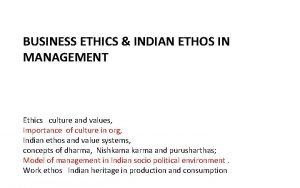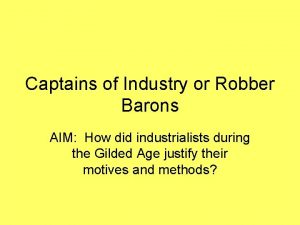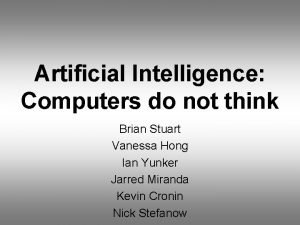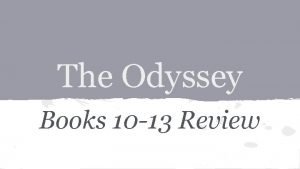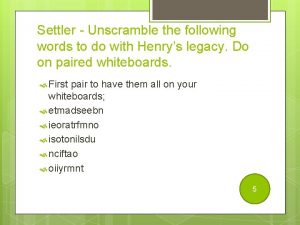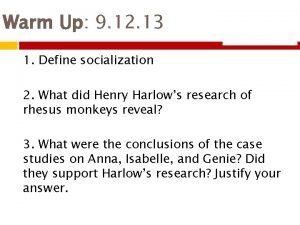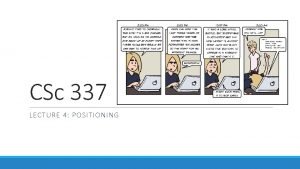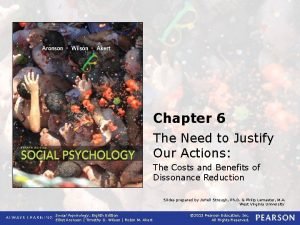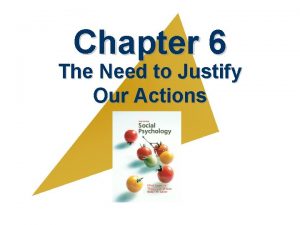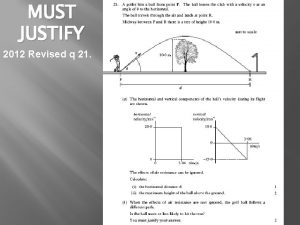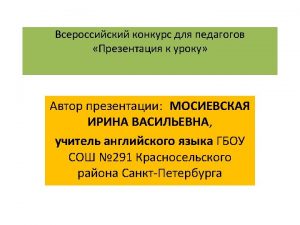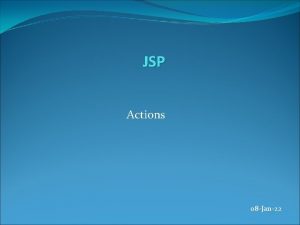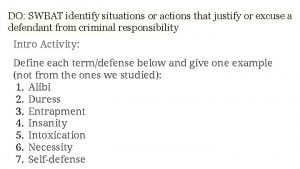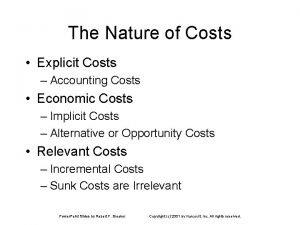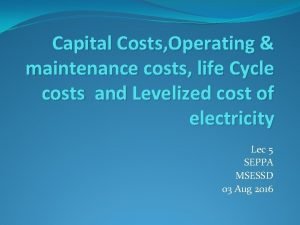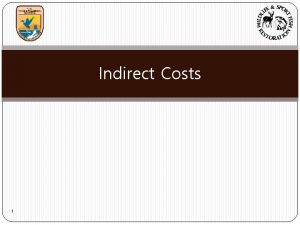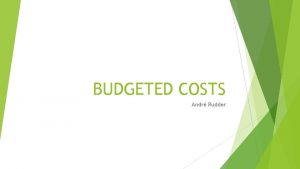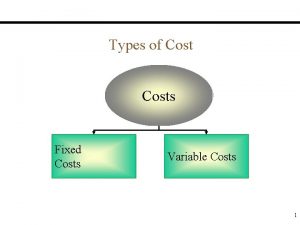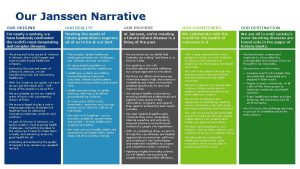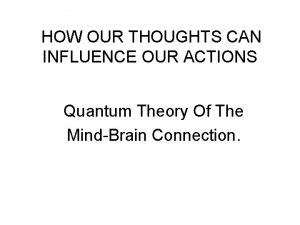The Need to Justify Our Actions The Costs




















































- Slides: 52

The Need to Justify Our Actions: The Costs and Benefits of Dissonance Reduction CHAPTER 6 Copyright © 2016, 2013, 2010 Pearson Education, Inc. All Rights Reserved

HEAVEN’S GATE CULT Believed that a space ship was coming to transport them � Needed � Spaceship failed to appear behind Hale-Bopp Comet � Continued with plan anyway to rid selves of “current containers” (own body) Mass suicide What is the process by which intelligent, sane people can succumb to such fantastic thinking and self-destructive behavior? Copyright © 2016, 2013, 2010 Pearson Education, Inc. All Rights Reserved

THE THEORY OF COGNITIVE DISSONANCE 6. 1 What is cognitive dissonance, and how do people avoid dissonance to maintain a positive self-image?

WHEN COGNITIONS CONFLICT (1 OF 2) Cognitive Dissonance: � discomfort that people feel when two cognitions (beliefs, attitudes) conflict, or when they behave in ways that are inconsistent with their conception of themselves Copyright © 2016, 2013, 2010 Pearson Education, Inc. All Rights Reserved

A LESSON IN COGNITIVE DISSONANCE Copyright © 2016, 2013, 2010 Pearson Education, Inc. All Rights Reserved

FESTINGER AND CARLSMITH, 1959 (1 OF 4) Cover story � The effect of “interest instructions” on performance on a boring task Copyright © 2016, 2013, 2010 Pearson Education, Inc. All Rights Reserved

FESTINGER AND CARLSMITH, 1959 (2 OF 4) IV = $ for telling a lie � $20. 00 large external justification: “sufficient” � $1. 00, small external justification: “insufficient” � control no $, no lie DV = enjoyment of the task Copyright © 2016, 2013, 2010 Pearson Education, Inc. All Rights Reserved

FESTINGER AND CARLSMITH, 1959 (3 OF 4) Students paid $20 for lying—for saying that the tasks had been enjoyable � Rated � $20 the task as dull and boring was sufficient external justification for lying $20 reduced dissonance between positive view of self (honest person) & behavior (lying) Lied because was paid to do so Copyright © 2016, 2013, 2010 Pearson Education, Inc. All Rights Reserved

FESTINGER AND CARLSMITH, 1959 (4 OF 4) Students paid only $1 for lying (saying the boring task was fun) � Rated the task as significantly more enjoyable � External justification was insufficient � Reduced dissonance via internal justification Changed attitude about task Believed the lie they told Copyright © 2016, 2013, 2010 Pearson Education, Inc. All Rights Reserved

THREE WAYS TO REDUCE DISSONANCE 1. Change behavior 2. Justify behavior by changing one of the dissonant cognitions 3. Justify behavior by adding new cognitions Copyright © 2016, 2013, 2010 Pearson Education, Inc. All Rights Reserved

FIGURE 6. 1 HOW WE REDUCE COGNITIVE DISSONANCE THERE ARE THREE BASIC WAYS OF REDUCING DISSONANCE: CHANGE YOUR BEHAVIOR, CHANGE YOUR COGNITION, OR ADD A NEW COGNITION. Copyright © 2016, 2013, 2010 Pearson Education, Inc. All Rights Reserved

SELF-AFFIRMATION Bolster the self-concept Reducing dissonance by adding a cognition about other positive attributes Copyright © 2016, 2013, 2010 Pearson Education, Inc. All Rights Reserved

DISSONANCE AND THE SELF-CONCEPT Dissonance most painful when one of the cognitions is about the self � Particularly true for those with high self-esteem Temporary blows to self-esteem can lead to greater behaviors consistent with low opinion of the self (e. g. , cheat) Copyright © 2016, 2013, 2010 Pearson Education, Inc. All Rights Reserved

DECISIONS, DECISIONS Every time we make a decision, we experience dissonance. � Chosen alternative has some negative aspects � Rejected alternative has some positive aspects Copyright © 2016, 2013, 2010 Pearson Education, Inc. All Rights Reserved

IMPACT BIAS The tendency to overestimate the intensity and duration of our emotional reactions to future negative events. � What we fail to recognize is that dissonance reduction often helps us back bounce quickly. � reducing dissonance is largely unconscious Copyright © 2016, 2013, 2010 Pearson Education, Inc. All Rights Reserved

THE COLLEGE DECISION LIFE IS FULL OF TOUGH CHOICES, LIKE WHERE TO ATTEND COLLEGEO. NCE WE MAKE A DECISION, WE OFTEN INFLATE THE IMPORTANCE OF POSITIVE ASPECTS OF OUR CHOICE (I. E. , THE COLLEGE WE SELECTED) AND MINIMIZE THE POSITIVE ASPECTS OF THE OTHER ALTERNATIVES (I. E. , THE COLLEGES WE DIDN’T SELECT). Source: Jeff Greenberg/Alamy Copyright © 2016, 2013, 2010 Pearson Education, Inc. All Rights Reserved

DISTORTING OUR LIKES AND DISLIKES (1 OF 2) Distort likes and dislikes � Downplay Negative aspects of chosen alternative Positive aspects of rejected alternative Copyright © 2016, 2013, 2010 Pearson Education, Inc. All Rights Reserved

DISTORTING OUR LIKES AND DISLIKES (2 OF 2) Postdecision Dissonance: Dissonance aroused after making a decision, typically reduced by enhancing the attractiveness of the chosen alternative and devaluating the rejected alternatives Copyright © 2016, 2013, 2010 Pearson Education, Inc. All Rights Reserved

THE PERMANENCE OF THE DECISION More important decisions = More dissonance Greater permanence = More dissonance � Permanence of decision How difficult it is to revoke Copyright © 2016, 2013, 2010 Pearson Education, Inc. All Rights Reserved

BUYING A NEW CAR: WHAT POSTDECISION EFFECT? ALL SALES ARE FINAL. WHEN WILL THESE CUSTOMERS BE HAPPIER WITH THEIR NEW CAR: TEN MINUTES BEFORE THE PURCHASE OR TEN MINUTES AFTER? Source: Industrieblick/Fotolia Copyright © 2016, 2013, 2010 Pearson Education, Inc. All Rights Reserved

CREATING THE ILLUSION OF IRREVOCABILITY (1 OF 2) When decisions are permanent (irrevocable) � Dissonance � Motivation increases to reduce dissonance increases Copyright © 2016, 2013, 2010 Pearson Education, Inc. All Rights Reserved

CREATING THE ILLUSION OF IRREVOCABILITY (2 OF 2) Lowballing � Salesperson induces a customer to agree to purchase a product at a very low cost, subsequently claims it was an error, and then raises the price. � Frequently, the customer will agree to make the purchase at the inflated price. Copyright © 2016, 2013, 2010 Pearson Education, Inc. All Rights Reserved

THREE REASONS LOWBALLING WORKS 1. Sense of commitment 2. Sense of commitment triggers the anticipation of an exciting event 3. Price only slightly higher than other prices elsewhere Copyright © 2016, 2013, 2010 Pearson Education, Inc. All Rights Reserved

THE DECISION TO BEHAVE IMMORALLY Moral dilemmas � Implications for self-esteem Dissonance reduction � People may behave either more ethically or less ethically in the future Copyright © 2016, 2013, 2010 Pearson Education, Inc. All Rights Reserved

DISSONANCE REDUCTION AND PERSONAL VALUES (1 OF 2) (Mills, 1958) Measured 6 th graders’ attitudes about cheating Gave opportunity to cheat in a game � Easy to cheat � Cheating almost necessary to win � Believed cheating could not be detected Copyright © 2016, 2013, 2010 Pearson Education, Inc. All Rights Reserved

DISSONANCE REDUCTION AND PERSONAL VALUES (2 OF 2) Cheaters � Became more lenient toward cheating Noncheaters � Became less lenient toward cheating Copyright © 2016, 2013, 2010 Pearson Education, Inc. All Rights Reserved

DISSONANCE, CULTURE, AND THE BRAIN Dissonant information � Reasoning Dissonance is reduced � Emotion circuits of brain shut down circuits activated Primates also show changes in what is valued after making a decision Copyright © 2016, 2013, 2010 Pearson Education, Inc. All Rights Reserved

DISSONANCE ACROSS CULTURES Process of dissonance reduction � Culturally universal Content of dissonance reduction � Cultural differences What thoughts are added, changed differ by culture Copyright © 2016, 2013, 2010 Pearson Education, Inc. All Rights Reserved

SELF-JUSTIFICATION IN EVERYDAY LIFE 6. 2 How does cognitive dissonance operate in everyday life, and what are some constructive ways of reducing it?

Justification of Effort The tendency for individuals to increase their liking for something they have worked hard to attain. Copyright © 2016, 2013, 2010 Pearson Education, Inc. All Rights Reserved

THE JUSTIFICATION OF EFFORT (1 OF 3) Aronson and Mills 1959 study Cover story: College students volunteered to join a group that would be meeting regularly to discuss various aspects of the psychology of sex. Copyright © 2016, 2013, 2010 Pearson Education, Inc. All Rights Reserved

THE JUSTIFICATION OF EFFORT (2 OF 3) Aronson and Mills (1959): IV � Severity of group initiation 1/3 participants: extremely demanding, unpleasant initiation 1/3: mildly unpleasant 1/3: admitted to group without any initiation DV � Liking of group after admitted Copyright © 2016, 2013, 2010 Pearson Education, Inc. All Rights Reserved

THE JUSTIFICATION OF EFFORT (3 OF 3) Aronson and Mills (1959) Mild initiation or no effort: less liking of group Severe initiation: more liking of group Copyright © 2016, 2013, 2010 Pearson Education, Inc. All Rights Reserved

FIGURE 6. 3 THE JUSTIFICATION OF EFFORT THE MORE EFFORT WE PUT INTO BECOMING MEMBERS OF A GROUP, AND THE TOUGHER THE INITIATION, THE MORE WE WILL LIKE THE GROUP WE HAVE JUST JOINED—EVEN IF IT TURNS OUT TO BE A DUD. (Adapted from Aronson & Mills, 1959. ) Copyright © 2016, 2013, 2010 Pearson Education, Inc. All Rights Reserved

THE ROLE OF PAIN IN RITUAL A DEVOTEE PARTICIPATES IN A RITUAL AS PART OFHTHE INDU FESTIVAL OF THAIPUSAM. Source: Shariff Che'Lah/Fotolia Copyright © 2016, 2013, 2010 Pearson Education, Inc. All Rights Reserved

EXTERNAL VERSUS INTERNAL JUSTIFICATION External Justification �A reason or an explanation for dissonant personal behavior that resides outside the individual (e. g. , to receive a large reward or avoid a severe punishment) Internal Justification � The reduction of dissonance by changing something about oneself (e. g. , one’s attitude or behavior) Copyright © 2016, 2013, 2010 Pearson Education, Inc. All Rights Reserved

DO CELEBRITIES BELIEVE THEIR ENDORSEMENTS? CELEBRITIES ARE PAID HUGE AMOUNTS OF MONEY TO ENDORSE PRODUCTSD. O YOU THINK THAT BRAD PITT BELIEVES THE MESSAGE HE IS DELIVERING ABOUT THIS EXPENSIVE WATCH? IS THE JUSTIFICATION FOR HIS ENDORSEMENT INTERNAL OR EXTERNAL? Source: Splash News/Newscom Copyright © 2016, 2013, 2010 Pearson Education, Inc. All Rights Reserved

PUNISHMENT AND SELF-PERSUASION (1 OF 3) If threat of punishment for engaging in a forbidden behavior is severe � There is sufficient external justification for refraining from behavior If punishment is less severe � There is insufficient external justification � Creates greater need for internal justification Change attitudes via self-persuasion Copyright © 2016, 2013, 2010 Pearson Education, Inc. All Rights Reserved

PUNISHMENT AND SELF-PERSUASION (3 OF 3) When external justification for resisting an object or activity is insufficient: � Dissonance � Reduce is aroused dissonance by Self-persuasion e. g. , devaluing forbidden activity or object Copyright © 2016, 2013, 2010 Pearson Education, Inc. All Rights Reserved

THE LASTING EFFECTS OF SELF-PERSUASION (4 OF 4) Self-Persuasion �A long-lasting form of attitude change that results from attempts at self-justification Copyright © 2016, 2013, 2010 Pearson Education, Inc. All Rights Reserved

FIGURE 6. 5 EXTERNAL VERSUS INTERNAL JUSTIFICATION AS THIS GRAPHIC SUMMARIZES, INSUFFICIENT PUNISHMENT OR REWARD LEADS TO SELF-JUSTIFICATION, WHICH IN TURN LEADS TO SELF-PERSUASION AND LASTING CHANGEL. ARGER REWARDS OR PUNISHMENTS MAY PRODUCE TEMPORARY COMPLIANCE, WHICH RARELY LASTS. Copyright © 2016, 2013, 2010 Pearson Education, Inc. All Rights Reserved

THE HYPOCRISY PARADIGM Induce hypocrisy � Make person aware of conflict between Attitudes Behavior � Hypocrisy � Reduce creates dissonance by changing behavior e. g. , attitudes about condoms and use of condoms Copyright © 2016, 2013, 2010 Pearson Education, Inc. All Rights Reserved

JUSTIFYING GOOD DEEDS AND HARMFUL ACTS “The Ben Franklin Effect” � when we dislike someone, if we do them a favor, we will like them more Behavior is dissonant with attitude Change attitude about person to resolve dissonance Copyright © 2016, 2013, 2010 Pearson Education, Inc. All Rights Reserved

FIGURE 6. 6 THE JUSTIFICATION OF KINDNESS IF WE HAVE DONE SOMEONE A PERSONAL FAVOR (BLUE BAR), WE ARE LIKELY TO FEEL MORE POSITIVELY TOWARD THAT PERSON THAN IF WE DON ’T DO THE FAVOR (ORANGE BAR) OR DO THE FAVOR BECAUSE OF AN IMPERSONAL REQUEST (YELLOW BAR). (Based on data in Jecker & Landy, 1969. ) Copyright © 2016, 2013, 2010 Pearson Education, Inc. All Rights Reserved

THE BEN FRANKLIN EFFECT WITHOUT REALIZING IT, BEN FRANKLIN MAY HAVE BEEN THE FIRST DISSONANCE THEORIST. Source: Library of Congress Prints and Photographs Division Washington [LCUSZC 47214] Copyright © 2016, 2013, 2010 Pearson Education, Inc. All Rights Reserved

DEHUMANIZING THE ENEMY: JUSTIFYING CRUELTY (1 OF 2) Cruel behavior is dissonant with view of self as a decent human being � Resolve dissonance by changing thoughts about victim Davis and Jones (1960) � Participants told a young man (confederate) they thought he was shallow, untrustworthy, boring. Copyright © 2016, 2013, 2010 Pearson Education, Inc. All Rights Reserved

DEHUMANIZING THE ENEMY: JUSTIFYING CRUELTY (2 OF 2) Participants convinced themselves � They � He didn’t like the victim deserved to be hurt Copyright © 2016, 2013, 2010 Pearson Education, Inc. All Rights Reserved

DEHUMANIZING MINORITIES AS EVIDENT IN THIS RACIST PROPAGANDA FROM AN ELECTION INPENNSYLVANIA IN THE 1860’S, WHITE EFFORTS TO DEHUMANIZE BLACKS MADE IT EASIER FOR THEM TO TREAT BLACK PEOPLE CRUELLY AND JUSTIFY DISCRIMINATION AND OTHER BRUTAL ACTS AGAINST THEMD. EHUMANIZATION OF OUTGROUPS, MINORITIES, OR ENEMIES IS AN UNFORTUNATELY COMMON WAY OF REDUCING DISSONANCE. Source: Library of Congress Prints and Photographs Division [LC-USZ 62 -40764] Copyright © 2016, 2013, 2010 Pearson Education, Inc. All Rights Reserved

FINAL THOUGHTS ON DISSONANCE: LEARNING FROM OUR MISTAKES Understanding cognitive dissonance allows one to understand some extreme behaviors (e. g. , Heaven’s Gate) Dissonance-reducing behavior maintains self-esteem But must also learn from mistakes and incorrect beliefs Copyright © 2016, 2013, 2010 Pearson Education, Inc. All Rights Reserved

JUST PLAIN FOLKS THE MEMBERS OF THEHEAVEN’S GATE CULT WERE JUST PLAIN FOLKS OF ALL RACES, BACKGROUNDSAND , WALKS OF LIFE. YET ALMOST ALL OF THEM EVENTUALLY COMMITTED SUICIDE BECAUSE OF THEIR COMMITMENT TO THE CULT AND ITS BELIEFS, AN EXTREME RESULT OF THE MECHANISM OF COGNITIVE DISSONANCE THAT ALL OF US EXPERIENCE. Source: tl: The Durango Herald/AP Images; tr: The Denver Post/AP Images; bl: Department of Motor Vehicles/AP Images; br: Tribune Newspapers/AP Images Copyright © 2016, 2013, 2010 Pearson Education, Inc. All Rights Reserved

POLITICS AND SELF-JUSTIFICATION Example: War in Iraq based on belief of WMDs When no WMDs were found, had to reduce dissonance between two thoughts: 1. “We believed there were WMD that justified this war” 2. “We were wrong” Justified war by stating goal was to liberate nation from cruel dictator Copyright © 2016, 2013, 2010 Pearson Education, Inc. All Rights Reserved

OVERCOMING DISSONANCE Acknowledging mistakes and taking responsibility is easier said than done Process of self-justification is unconscious, but once we know we can justify our actions, we can monitor our thinking and behavior When you are confronted with evidence that you are wrong, will you justify that mistake or strive to correct it? Copyright © 2016, 2013, 2010 Pearson Education, Inc. All Rights Reserved
 Why food quality is important
Why food quality is important Human act and act of man
Human act and act of man Components of indian ethos
Components of indian ethos Our census our future
Our census our future Awareness of ourselves and our environment is:
Awareness of ourselves and our environment is: Our census our future
Our census our future Our awareness of ourselves and our environment is called
Our awareness of ourselves and our environment is called Longing for peace our world is troubled
Longing for peace our world is troubled Our life is what our thoughts make it
Our life is what our thoughts make it God our father christ our brother
God our father christ our brother Our life is what our thoughts make it
Our life is what our thoughts make it Money madness
Money madness Thinking affects our language which then affects our
Thinking affects our language which then affects our Awareness of ourselves and our environment is
Awareness of ourselves and our environment is Our future is in our hands quotes
Our future is in our hands quotes We bow our hearts
We bow our hearts Awareness of ourselves and our environment is:
Awareness of ourselves and our environment is: Envelope tool
Envelope tool How did robber barons justify their wealth
How did robber barons justify their wealth Do computers surpass man's intelligence justify
Do computers surpass man's intelligence justify Actual self and ideal self
Actual self and ideal self Stop trying to justify yourself
Stop trying to justify yourself Who transforms odysseus’s sailors into pigs
Who transforms odysseus’s sailors into pigs Compromise enables maine and missouri
Compromise enables maine and missouri Justify the title keeping quiet
Justify the title keeping quiet Settler unscramble
Settler unscramble Hidden curriculum
Hidden curriculum Alignitems vs justify content
Alignitems vs justify content ưu thế lai là gì
ưu thế lai là gì Thẻ vin
Thẻ vin Bàn tay mà dây bẩn
Bàn tay mà dây bẩn Thể thơ truyền thống
Thể thơ truyền thống Các châu lục và đại dương trên thế giới
Các châu lục và đại dương trên thế giới Bổ thể
Bổ thể Từ ngữ thể hiện lòng nhân hậu
Từ ngữ thể hiện lòng nhân hậu Tư thế ngồi viết
Tư thế ngồi viết Diễn thế sinh thái là
Diễn thế sinh thái là V cc cc
V cc cc Phép trừ bù
Phép trừ bù Hát lên người ơi
Hát lên người ơi Sự nuôi và dạy con của hươu
Sự nuôi và dạy con của hươu đại từ thay thế
đại từ thay thế Vẽ hình chiếu vuông góc của vật thể sau
Vẽ hình chiếu vuông góc của vật thể sau Cong thức tính động năng
Cong thức tính động năng Tỉ lệ cơ thể trẻ em
Tỉ lệ cơ thể trẻ em Thế nào là mạng điện lắp đặt kiểu nổi
Thế nào là mạng điện lắp đặt kiểu nổi Hát kết hợp bộ gõ cơ thể
Hát kết hợp bộ gõ cơ thể Dạng đột biến một nhiễm là
Dạng đột biến một nhiễm là Lời thề hippocrates
Lời thề hippocrates Vẽ hình chiếu đứng bằng cạnh của vật thể
Vẽ hình chiếu đứng bằng cạnh của vật thể Quá trình desamine hóa có thể tạo ra
Quá trình desamine hóa có thể tạo ra Phản ứng thế ankan
Phản ứng thế ankan Kể tên các môn thể thao
Kể tên các môn thể thao


